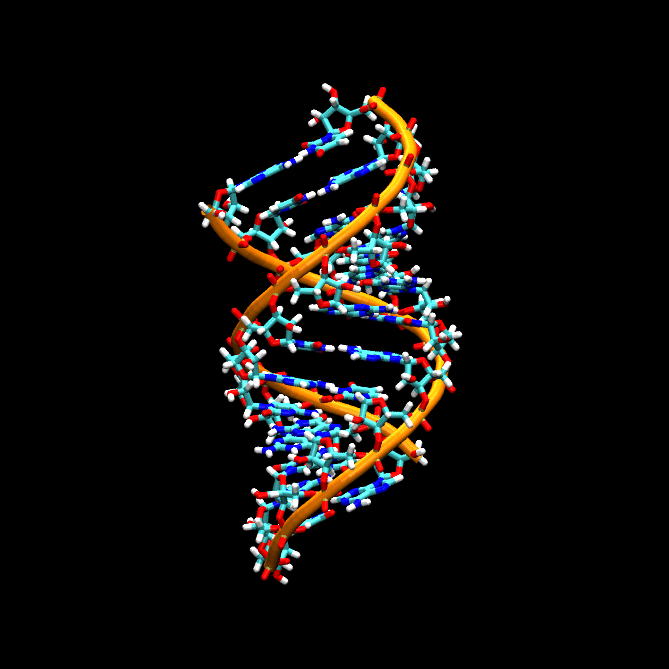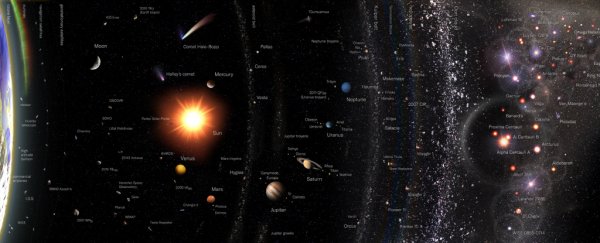The building blocks of life can, and did, spontaneously assemble under the right conditions. That's called spontaneous generation, or abiogenesis. Of course, many of the details remain hidden to us, and we just don't know exactly how it all happened.
Or how frequently it could happen.
The world's religions have different ideas of how life appeared, of course, and they invoke the magical hands of various supernatural deities to explain it all. But those explanations, while colorful tales, leave many of us unsatisfied.
'How did life arise' is one of life's most compelling questions, and one that science continually wrestles with.
Tomonori Totani is one scientist who finds that question compelling. Totani is a professor of Astronomy at the University of Tokyo. He's written a new paper titled Emergence of life in an inflationary universe. It's published in Nature Scientific Reports.
Totani's work leans heavily on a couple concepts. The first is the vast age and size of the Universe, how it's inflated over time, and how likely events are to occur. The second is RNA; specifically, how long a chain of nucleotides needs to be in order to "expect a self-replicating activity" as the paper says.
Totani's work, like almost all work on abiogenesis, looks at the basic components of life on Earth: RNA, or ribonucleic acid. DNA sets the rules for how individual life forms take shape, but DNA is much more complex than RNA.
RNA is still more complex, by orders of magnitude, than the raw chemicals and molecules found in space or on the surface of a planet or moon. But its simplicity compared to DNA makes it more likely to occur via abiogenesis.
There's also one theory in evolution saying that although DNA carries the instructions to build an organism, it's RNA that regulates the transcription of DNA sequences. It's called RNA-based evolution, and it says that RNA is subject to Darwinian natural selection, and is also heritable. That's some of the rationale behind looking at RNA vs DNA.
 Double stranded RNA. (Supyyyy/Wikimedia/CC By 4.0)
Double stranded RNA. (Supyyyy/Wikimedia/CC By 4.0)
RNA is a chain of chemicals known as nucleotides. Some research shows that a chain of nucleotides needs to be at least 40 to 100 nucleotides long before the self-replicating behaviour called life can exist.
Over time, enough nucleotides can form a chain to meet that length requirement. But the question is, has there been enough time in the life of the Universe? Well, we're here, so the answer must be yes, mustn't it?
But wait. According to a press release announcing this new paper, "… current estimates suggest that magic number of 40 to 100 nucleotides should not have been possible in the volume of space we consider the observable universe."
The key here is the term 'observable universe.'
"However, there is more to the universe than the observable," said Totani. "In contemporary cosmology, it is agreed the universe underwent a period of rapid inflation producing a vast region of expansion beyond the horizon of what we can directly observe. Factoring this greater volume into models of abiogenesis hugely increases the chances of life occurring."
Our Universe came into being during the Big Bang, a single inflation event. According to Totani's paper, our Universe "likely includes more than 10^100 Sun-like stars," whereas the observable Universe only contains about 10 sextillion (10^22) stars.
We know that life has occurred at least once, so it's not out of the question that abiogenesis occurred at least once more, even if the chances are infinitesimally tiny.
According to statistics, the amount of matter in the observable Universe should only be able to produce RNA that is 20 nucleotides long, well under the 40 to 100 number. But because of rapid inflation, much of the Universe is unobservable. It's simply too far away for light emitted since the Big Bang to reach us.
When cosmologists add up the number of stars in the observable Universe with the number of stars in the unobservable Universe, the resulting number is 10^100 Sun-like stars. That means there is much more matter in play, and the abiogenic creation of long enough chains of RNA is not only possible, but probable, or even inevitable.
In his paper, Professor Totani states the basic relationship under investigation. "Here, a quantitative relation is derived between the minimum RNA length/min required to be the first biological polymer, and the universe size necessary to expect the formation of such a long and active RNA by randomly adding monomers."
Is it getting confusing? Here's a hopefully more manageable summary.
The Universe is larger than its observable portion, and likely contains 10^100 Sun-like stars. For the probability of abiotic creation of RNA on an Earth-like planet to equal 1, or unity, then the minimum nucleotide length must be less than about 20 nucleotides, which is much smaller than the initially stated minimum of 40 nucleotides.
But scientists don't think that RNA only 20 nucleotides long can be self-replicating, at least not from our perspective as observers of terrestrial life. As Totani says in his paper, "Therefore, if extraterrestrial organisms of a different origin from those on Earth are discovered in the future, it would imply an unknown mechanism at work to polymerize nucleotides much faster than random statistical processes."
What would that process be?
Who knows, but this is likely an inflection point where people of faith can chime in and say, "Why God, of course."
Totani's work has by no means provided an answer. But like a lot of scientific work, it helps refine the question, and invites other to study it.
"Like many in this field of research, I am driven by curiosity and by big questions," said Totani.
"Combining my recent investigation into RNA chemistry with my long history of cosmology leads me to realize there is a plausible way the universe must have gone from an abiotic (lifeless) state to a biotic one. It's an exciting thought and I hope research can build on this to uncover the origins of life."
This article was originally published by Universe Today. Read the original article.
